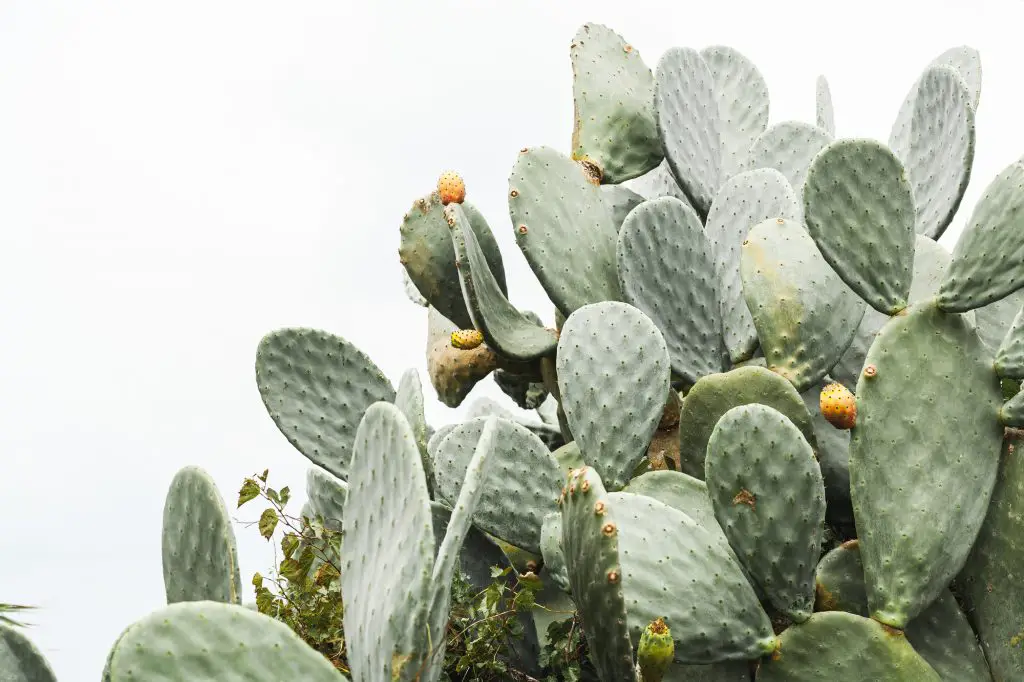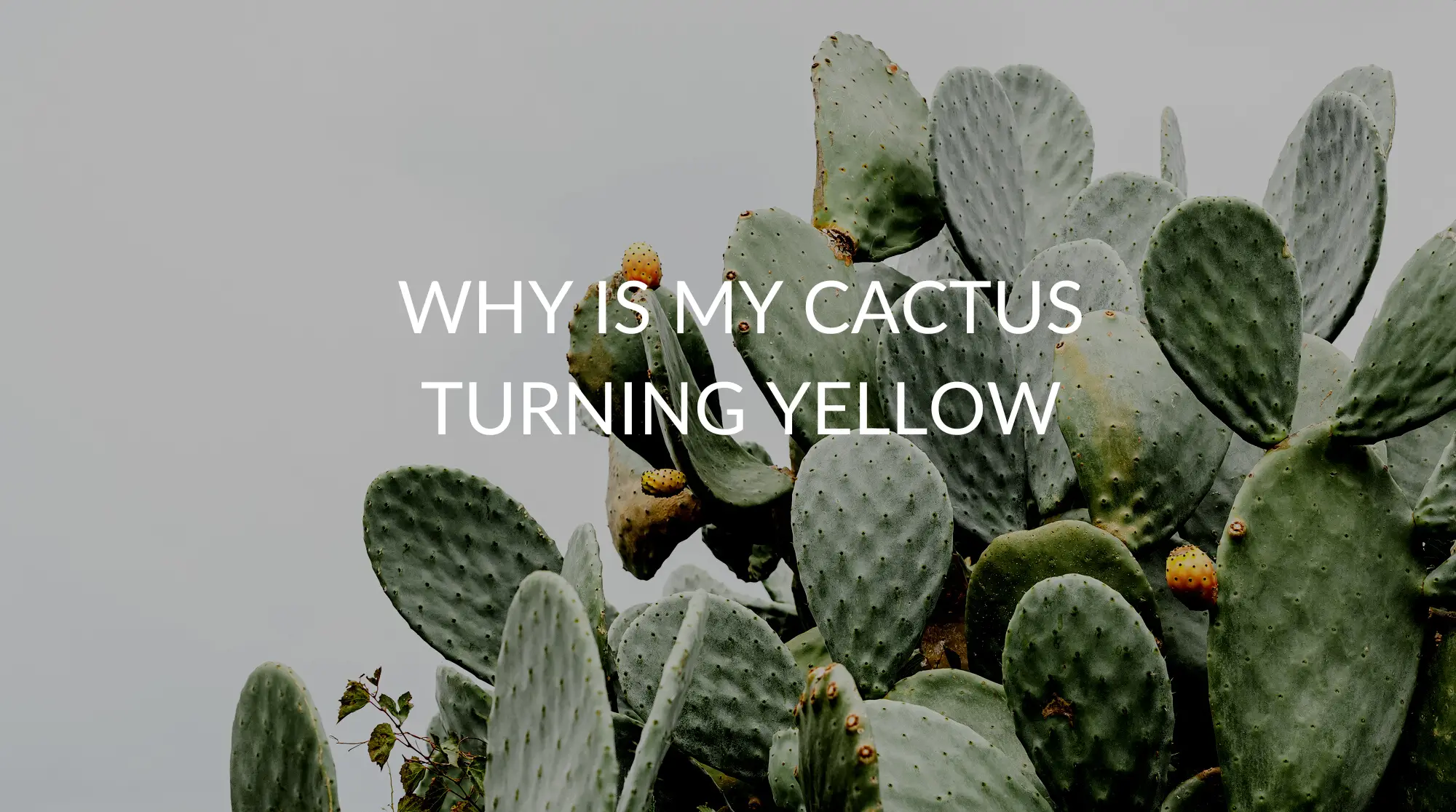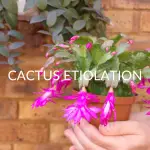Cacti are a magnificent family of plants that come in a wide variety of colors, shapes, and sizes and with many different characteristics. Many people take up the enjoyable hobby of growing cacti because of how easy they are to maintain and their intriguing look. However, sometimes our cacti can display unfavorable symptoms, such as yellowing which can cause concern.
Cacti can turn yellow for a variety of reasons, some of them including too much direct sunlight, insufficient soil composition, too small of a pot, plant stress, lack of water, insect infestation, and being too dry. To successfully determine the exact cause, growers should focus on diagnosing based on observable symptoms.
Since there are so many various reasons why cacti can begin to yellow, it’s very important that growers pay close attention to the different signs (other than yellowing) their cactus is displaying. This article will not only provide you with information about why your cactus is turning yellow but if it will turn green again and how to prevent your cactus from yellowing.
Why Is My Cactus Turning Yellow?
As mentioned earlier, a cactus can begin to yellow for a lot of different reasons. Correctly determining what’s causing your cactus to yellow begins with observing symptoms other than yellowing in your plant as well as considering the environment it’s in. Causes may not be identifiable at first, but with holistic observation, it can be done.
Too Much Lighting
Cacti can begin to yellow because they are receiving too much sunlight. The tricky part of diagnosing this problem is that, generally, cacti thrive in direct sunlight. However, if your cactus is potted and moved from an area that receives less sunlight than where you moved it, it can begin to get discolored from being sunburnt.
Wrong Soil Type
Your cactus can begin to yellow because of incorrect soil composition. Cacti require well-draining soil mixtures to thrive and do not do well in clay or compacted soil. If the roots of your cactus become compacted with too much dirt or clay, they may begin to rot- causing the cactus to be yellow.
Overwatering
Your cactus can begin to show yellowing from the base up when it has been overwatered. Overwatering puts your cactus at risk for yellowing as well. If you overwater your cactus, you put it at risk of root rot, and yellowing may begin to become observable, especially if the soil remains consistently damp and the temp is lower than 40 degrees Fahrenheit.
Underwatering
Another reason for cacti yellowing can be underwatering. If you don’t water at least every 1-2 weeks during its active growing season and at least 3-4 weeks during its inactive seasons, you may be putting your cactus at risk for yellowing due to being underwatered. You should be giving your cactus enough water to moisten its soil at each watering session.
Not Enough Sunlight
Just as it’s risky to give your cactus too much sunlight, it can also begin yellowing due to not getting enough direct sunlight. If your cactus begins to yellow, your cactus is in a darker area, and the above-listed causes have been ruled out, you might consider moving your plant so that it receives more sunlight.
Poor Quality Soil
Sometimes cacti can begin to yellow because of a lack of nutrients and vitamins in the soil they’re planted in. Cacti generally require soil that is aerated and has additional nutrients such as iron and calcium. Failing to meet these requirements and/or using regular potting mix instead of cactus/succulent soil mixes can cause yellowing in a cactus plant.
Temperature Changes
Another problem cacti face in terms of yellowing includes dramatic temperature changes. This is a common cause for yellowing in cacti and can be diagnosed easily- if the cactus has been moved from one place to another or by something that produces cold or heat, or even just has experienced a natural temperature shift outside, this may be the reason.
Too Much/Little Fertilizer
Cacti can turn yellow because of being fertilized too much or too little. Applying too much fertilizer can give your cactus a chemical burn or cause yellowing. Too much fertilizer containing salt can build up on the soil surface of your plant and block water from reaching its roots. To fix this, you should refrain from using fertilizer for two weeks.

Pests
Another common reason for cacti yellowing is the invasion of unwanted cactus predators and pests. These pests usually present themselves as mealy bugs or spider mites, which reproduce at exponential rates and are quickly and easily able to destroy the plant. You should look for not only yellowing but for the pests as well to be able to accurately determine this as the cause.
Various Diseases
Cacti can also experience yellowing due to the contraction of various illnesses and diseases. One such infection is one that causes water-conducting tissues in the cactus to become necrotic, losing their ability to move water throughout the cactus’ other tissues. Another cause of yellowing can be an illness called chlorosis, usually caused by iron deficiency.
Frost Damage
If your cactus has been exposed to extremely cold temperatures and then began to yellow, it may be due to the fact that it has experienced frost damage. If the cactus’s temperature drops below freezing overnight or during periods that have light freezing over multiple days, this may be the culprit.
Exposure To Certain Chemicals
If your cactus has a high buildup of chemicals such as chlorine, fluorine, and others that are commonly found in water and fertilizers, it can experience yellowing. If your cactus lives outside and you can’t think of any recent changes to its fertilizer or soil composition, your plant may have even been the victim of a nearby chemical spill.
Will A Yellow Cactus Turn Green Again?
It depends on what the cause of your cactus turning yellow as to whether it will turn green again or not. If it was majorly destroyed by pests, it would most likely fail to heal and return back to its normal green hues. However, if it was exposed to a sudden unfavorable change in temperature, it may bounce back if moved to a location that has a proper temperature.
Most cacti will not turn green again on their own after the yellowing process has been initiated, but if the whole plant has not yellowed, there may be hope for revival. If you suspect a soil problem, test the nutrient density of your soil and see if you can determine if it has a deficiency that is affecting your suffering cactus.
If you’ve recently moved your cactus and then the process of yellowing started, try moving it back to the location it was doing better in to notice any improvements. If it has been overwatered and you can visibly see the cactus is rotting and yellowing from the base up, this is usually critical and cannot be stopped once the rotting process has been started.
How To Save A Cactus That Is Turning Yellow
If you want to save a yellowing cactus, you need to know what treatment is necessary in order to properly help it. Depending on what is wrong with your plant, you will do different things in an attempt to revive it back to its original health. By obtaining a proper diagnosis of what’s affecting your plant, you can have a better shot at helping it recover.
Saving A Cactus Experiencing Too Much Light
If your cactus has been receiving too much sunlight and it’s starting to yellow because of it, you can simply move it to an area with less sunlight. If your cactus is on the larger side and lives outside, you can move it (although likely very tricky). An easier way to accommodate your outside cactus is to plant shade-bearing plants near your cactus to cast some shadows.
Saving A Cactus From The Wrong Soil Type
To save a yellowing cactus from the wrong type of soil, you should promptly and correctly transplant it from its currently unfavorable media to a more favorable media suitable for cacti and succulents. Be sure to avoid transplanting outside cacti to an area with compacted dirt and areas abundant in clay.
Saving A Cactus From Overwatering
It is likely more difficult to save a yellowing cactus from overwatering than it is to save it from any other debilitating condition. If you find your plant suffering from overwatering, you should immediately cease watering it until the soil dries up. You can also take care to transplant it to a new soil media to boost its chances for a successful recovery.
Saving A Cactus From Underwatering
To save your cactus from yellowing due to underwatering, you should immediately sufficiently water your cactus. You should also take care that your cactus is planted in soil that can adequately maintain and hold enough moisture content to sustain your cactus. Although cacti love dry atmospheres, they still require enough water to maintain their tissues.
Saving A Cactus From A Lack Of Sunlight
If you determine that your plant has not been receiving enough sunlight as the culprit for its yellowing, you should immediately either move your cactus to an area with more sunlight or increase the amount of artificial light it is receiving, if possible. If your cactus is outside and experiencing issues, try clearing any shade-producing plants or items that are nearby.
Saving A Cactus From Lack Of Good Quality Soil
If you find that your cactus plant is yellowing because of a lack of soil nutrients and quality, there are a couple of things you can do to save it. First, if low in iron, you should purchase a chelated iron powder or some blood meal and add it directly to your cactus’ soil. If low in calcium, you can add eggshells to your soil mixture.
Saving A Cactus From Temperature Changes
If your cactus has been exposed to extreme changes in temperature, you can try to revive it by trimming away the dead pieces of tissue, adjusting its temperature to be favorable, and trying your very best to imitate its natural habitat for the best results.
Saving A Cactus With Too Much/Little Fertilizer
If you’ve found your cactus has been receiving too much or too little fertilizer, you should simply begin adding more fertilizer or less fertilizer, depending on what the specific issue is. For cacti that have been severely overfertilized, ceasing fertilizing altogether for at least two weeks is recommended.
Saving A Cactus From Pests
To save your cactus from pests, you should immediately apply 70% isopropyl alcohol with a spray bottle to your plant to kill the insects. You can also spray a pesticide onto them, being careful to follow the directions accordingly.
Saving A Cactus From Various Infections/Diseases
To save your yellowing cactus from different infections and diseases, you should first remove any tissues being affected by the disease with a sharp, sterile knife or pruning shears. Next, control the cactus’ living conditions to halt any further outbreaks to maintain the infection and eventually eradicate it.
Saving A Cactus From Frost Damage
If your yellowing cactus plant has experienced frost damage, you can try to revive it by waiting until softened areas on your cactus turn black. Once this happens, you should prune back all the black tissue. If you observe your plant turn shades of green, white, and then purple, you should not do anything to revive your plant as it is likely healing by itself.
Saving A Cactus From Chemical Exposure
To save a cactus from experiencing yellowing due to harsh chemical exposure, you should quickly identify the source of the excess buildup of these unwanted chemicals. If your plant lives outside, you should be mindful of nearby factories, dumping facilities, and chemical runoff from neighbors. If your plant lives inside, try changing soil composition or your water resource.
Preventing Your Cactus From Yellowing
To prevent your cactus from yellowing in the future, a number of different actions can be taken (depending on what you determine are risk factors for your plant). Some of these preventative actions include:
- Keep your cactus on a watering schedule
- Use a photometer to be sure your plant isn’t receiving too much or too little sunlight
- Be careful when transplanting your cactus
- Choose soil that is aerated and, better yet, specifically for cacti and succulents to prevent root rot and nutritional deficiencies.
- Use clean tools when pruning and doing damage control on your plant
- Keep your cactus on a fertilizing schedule
- Routinely test your cactus’ soil (nutrients and pH)
- Learn exactly how much water your cactus requires to thrive sufficiently.
- Be sure you have enough windows and artificial lighting if growing your cactus indoors
- Be sure your land is clear of debris and too many shade-bearing items if your cactus is growing outside
- Be sure to limit the amount of direct sunlight your cactus receives
- Water your cactus every 1-2 weeks in its active seasons and 3-4 weeks during its inactive seasons
- Keep cacti out of dark areas
- Refrain from misting your cacti
- Allow for plenty of drainage in your cacti containers and plots
- Regularly touch your cactus’ soil to determine any fluctuating watering needs it may experience
- Monitor your home and outdoor temperatures to plan for any sudden unfavorable temperature changes that could affect your plant
- Use the correct fertilizer for your cactus
- Mix homemade cactus media evenly and well to ensure proper distribution of chemicals and nutrients to your cactus’ roots
- Avoid placing cacti directly in front of windows that receive a lot of direct sunlight.
- Supplement your indoor cactus with more artificial light if they’re not receiving a sufficient amount and windows are not an option.
- Check cacti roots every 2-3 months.
- Regularly monitor your cactus for pests to avoid major pest outbreaks
FAQs
How To Save Cactus That Is Turning Yellow In Winter?
When cacti begin to yellow in the wintertime, it is usually due to overwatering. To save your cactus from this, you should cease watering until the soil dries up, move it to an area with more light and keep its temperature in the range of 55-85 degrees Fahrenheit.
How To Save A Yellowing Cactus From Sunburn?
To save a cactus from sunburn, you should immediately move it to a location that’s out of the sun. Continue to provide an adequate amount of water and care for it in other areas it needs caring for until it can make a full recovery.
How To Save A Yellow, Wrinkled Cactus Due To Underwatering?
If your cactus is becoming yellow and wrinkled due to underwatering, you should water it generously so that its soil is evenly moist, helping to replenish its moisture reserves and eventually changing the cactus’ appearance from yellow back to green.
Summary
Cacti can turn yellow for different reasons, but being knowledgeable about the symptoms cacti exhibit when stressed will help you accurately determine which reason is most affecting your plant.
Although aspects such as watering habits, soil makeup, nutrients, sunlight, temperatures, and pests can negatively affect your cactus, knowing how to treat each condition is most of the battle.
Prevention is the best medicine for your cactus, so being aware of a cactus’ needs for consistently bright, indirect sunlight, sufficient moisture, and feeding habits is the first step in growing a happy plant.







